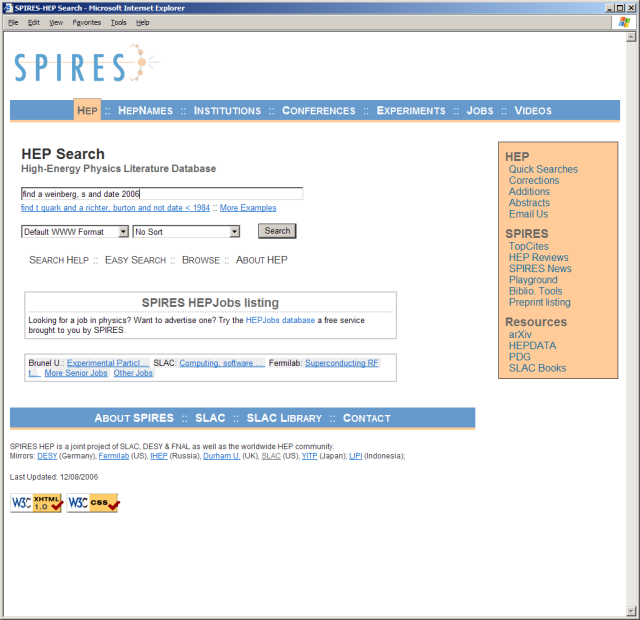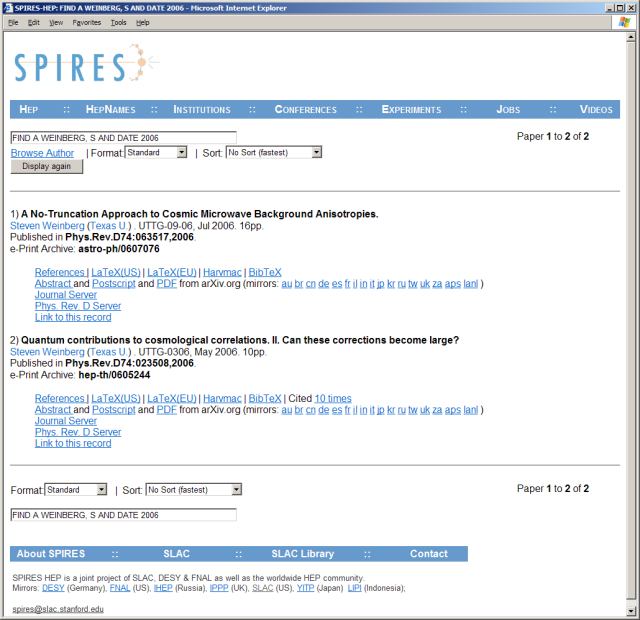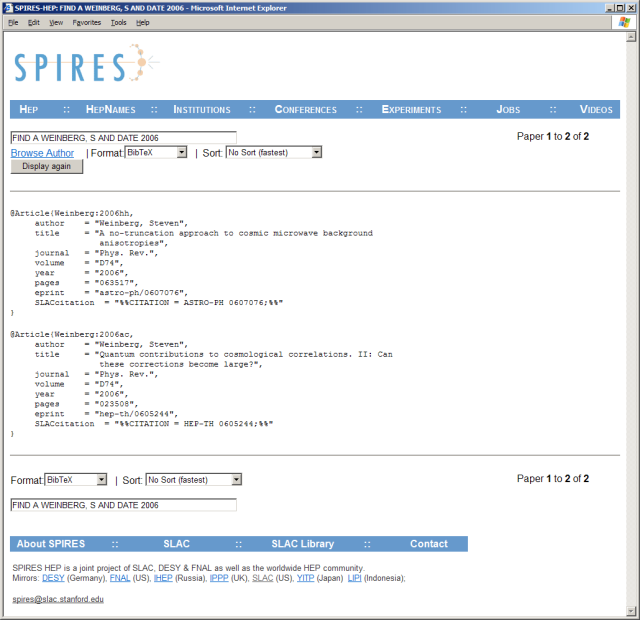| URLs in this document have been updated. Links enclosed in {curly brackets} have been changed. If a replacement link was located, the new URL was added and the link is active; if a new site could not be identified, the broken link was removed. |
Electronic Resources Reviews
SPIRES-HEP Database: The Mainstay of High-Energy Physics
Librarian
Department of Astronomy and Astrophysics
University of Toronto
Toronto, Ontario, Canada
robbins@astro.utoronto.ca
Introduction
The SPIRES-HEP database has been run by the Stanford Linear Accelerator Center (SLAC) since the late 1960s as a comprehensive database catalog of particle physics literature and information relevant to high-energy particle physicists. The SPIRES-HEP database is managed and maintained by the SLAC library, in collaboration with other high-energy physics institutions around the world. In 1991 it became the first web site in the Western hemisphere and now attracts around 50,000 searches per day from particle physicists. SPIRES-HEP facilitates access to the literature and reference tools of the field for free.SPIRES-HEP's success stems largely from its focused scope to distill and concentrate all bibliographic data in the field and provide centralized access to its target audience. The creators of the database were and are still integrated within the community that they serve. As the World Wide Web was created at CERN, the particle-physics laboratory in Geneva, Switzerland, it is only natural that the SPIRES-HEP literature database was the first database to be served over the World Wide Web.
As shown below, the database does an excellent job of organizing the diverse literature of particle physics and providing a rich toolset for searching and retrieving information. The size and coverage of the database makes it the essential tool to the worldwide high-energy particle physics community.
Background and History
The SPIRES-HEP (High-Energy-Physics) database was developed throughout the late 1960s and 1970s at the Stanford Linear Accelerator Center (SLAC) in California. It was designed to be the central repository and catalog for unpublished articles called preprints. Many physics institutions received thousands of paper preprints each year, articles made public before their publication in a journal. Preprints were the essential means of communication that allowed physicists, especially those in the theoretical community, to share their work and stay at the cutting-edge of research. The libraries at SLAC and Deutsches Elektronen Synchrotron (DESY) in Hamburg, Germany teamed up to jointly create the HEP database in order to organize and catalog bibliographic information for the numerous preprints received weekly from physics institutions from all over the world. SPIRES stands for the Stanford Physics Information REtrieval System (later renamed the Stanford Public Information REtrieval System). It is a collaboration that continues today as a joint project of SLAC, DESY, and Fermi National Accelerator Laboratory (Fermilab) in Illinois, USA, with contributions and support from the worldwide HEP community.In 1991, Paul Ginsparg at Los Alamos National Laboratory (LANL) created the electronic preprint arXiv repository for high-energy physics papers, which quickly became a de facto prepublication site where authors submitted their work and researchers could easily obtain papers. This was the perfect complement to the SPIRES database, which added links to the arXiv as part of their records.
The SPIRES-HEP database has expanded to create a central repository that facilitates access to the literature of high-energy physics and related fields for researchers all over the world. Another key factor to the success of the database is that the backing for its development and its continued support comes from the national and international laboratories and database access and use has been universally free to users and institutions since its inception.
Database Size, Content, and Scope
SPIRES has indexed more than half a million high-energy physics related articles, including journal papers, preprints, e-prints, technical reports, conference papers, and theses. The database connects preprint or e-print versions of articles subsequently published in journals or conference proceedings, providing access to all phases of the publication history.There are a number of other databases indexing very useful information in the field:
- HEP--e-prints, articles, conference and proceedings talks, theses, technical reports
- HEPNAMES--online directory of scientists
- Institutions--institutions directory
- Conferences--high-energy physics conferences
- Experiments--list of particle and astro-particle physics experiments
- Jobs--job listings (see below)
- Videos--a separate database of videos and streaming media talks
There are multiple replicas or mirrors of the SPIRES database, mostly hosted at national laboratories: SLAC (USA), DESY (Germany), Fermilab (USA), the Institute of High Energy Physics (IHEP, Protvino, Russia), Durham University (UK), Yukawa Institute of Theoretical Physics (YITP, Japan), and Indonesian Institute of Sciences (LIPI, Indonesia).
Searching and Search Interface
The SPIRES home page is clean and crisp and easy to read and all the search functionality is provided through a command line interface or through more familiar web forms. The search language or syntax has a particular vernacular that at first may be slightly non-intuitive for most people used to web forms or search engines. Each search field needs to be specified, e.g., author, title, etc. However, once the user is familiar with creating a search query the interface is fast, flexible, and easy to use. An "Easy Search" is provided which presents a more familiar web form with all the possible fields that can be searched allowing novice users to quickly get used to the organization of the database. With practice, it is easy to be very specific and to hone in to particular records of interest. The "Search Help" page provides extensive examples and information for searching.A third option for searching is "Browse," which provides a very simple web form to search for a term in one of the indexes. If there are multiple matches for an author search, a list of variants of the name are displayed with the number of records for each.
An example of a search (shown below) is for the most recent publications from Steven Weinberg who, as of the writing of this article, had a total of 205 entries in the database.
find a weinberg, s and date 2006
Note that key-terms such as "author" and "date" can be abbreviated to 'a' and 'd' respectively.

Specifying the year or part of a title or asking for topcites 1000+ can quickly narrow a search further to articles that could be interesting. One caveat is that searching on institutions or experiments is not as standardized as one would hope and it can take several attempts to specify a query to obtain the desired results. Nevertheless, to SPIRES' credit, this useful ability to search by an institution or experiment is not offered by most other search utilities.
HEP Help is a comprehensive help page that points an individual to a variety of ways in which to find a paper. Starting with a finding index to view all search options, author, title, e-print number, date, experiment etc., it also gives additional information on sorting, viewing, policies, and general SPIRES searching. The Quick Example Searches are very useful.
Display and Presentation of Search Results
Search results include the title, author or authors, report number, date, and page numbers. If available, the e-print archive number is also listed. SPIRES-HEP provides links to the full-text version of published works, including those submitted to the arXiv. A notation is included in the result record if an article has been submitted to a journal. Depending on the status of publication, links are provided to the abstract, PDF or PostScript versions of the article in the arXiv database (and all its mirrors), or to the publisher's web site, where the user's local site-license policies may apply. Records are updated when the publication status of an article changes. Each result record also lists links to the article references and to citations.Each author presented in the results is hyperlinked so that clicking on a name will bring up all records associated with that author. For multi-author articles, one first needs to click on the link of the first author name et al. This is extremely useful in the field of high-energy physics where author lists routinely run to hundreds of names.
Search results can be ordered in a number of ways: by ascending or descending date, first author name, title, or number of citations. The results can also be displayed in a standard format, by citation, summary of citations, or in a variety of formats useful for authors who need to include references in their own work such as LaTeX, BibTex, and CV format (more on this below). There is even an XML RSS feed format.
For the search on Steven Weinberg presented above, two results are returned as shown in the screen capture below showing the default standard results with links to the journal articles.

The following screen capture demonstrates the useful feature for authors where each record can be displayed as a formatted citation reference in BibTeX, LaTeX, or Harvmac format which can be cut-and-pasted into an author's work. The screen capture is in BibTeX format suitable for including in the references source file of an article in LaTeX format.

SPIRES also adds links in the results to other literature databases such as the CERN Library database, Harvard's Astrophysics Data System (ADS), and the American Mathematical Society's Mathematical Reviews (AMSMR).
One very useful feature is the citation links (see Citation Searching below). These provide links to works that have cited the article in question.
Finally a link is provided for those wishing to link back to the record in the SPIRES database.
Other Features
The SPIRES-HEP Jobs listings is another handy feature. The Jobs database lists jobs in the fields of core interest to the SPIRES-HEP community: astro-ph, gr-qc, hep-ex, hep-lat, hep-ph, hep-th, nucl-ex, nucl-th, physics.ins-det, and physics.acc-ph. It facilitates easy access to positions around the world that can be advertised free of charge and as soon as they are open. According to the database web site the Jobs database usually contains over 300 listings and receives over 1,500 hits per day. Users can post a new position and can be notified of new jobs via e-mail.
SPIRES-HEP Reviews
SLAC provides a list of review papers on certain topics within high-energy physics, updated annually. Some of these papers are carefully selected or are ones with a large number of citations (at least 100 by June 2004).It is possible to search more generally for review papers in SPIRES-HEP by using the search term 'scl r'. For example, find a wilczek and scl r finds all review papers written by physicist Frank Wilczek.
SPIRES News
There are some links to news items related to high-energy physics and SPIRES, but the latest news item listed as of this article is from October 2004. SPIRES News was discontinued with the advent of Interactions.org: Particle Physics News and Resources.
Playground
The HEP Statistics Playground is intended to share statistical data and information gathered from the SPIRES-HEP databases, e.g., citation data from many areas of physics, studies published in Symmetry Magazine, and other interesting and sometimes amusing information. Most of the information though is from 2003-2004.
SPIRES Bibliography Services
The Bibliography Services page gives a number of detailed help manuals for generating and checking bibliographic information in various formats (LaTeX, BibTeX) from the SPIRES HEP search engine.
Preprint Listing
The most recent week's preprints are listed by the SLAC library, ordered by report number, as well as the "anti-preprints," which are the most recent listing of published articles.
Citation Searching
Due to its comprehensive listing, the SPIRES database provides an excellent tool for citation listing and searching. SPIRES-HEP even provides citation tracking of an article through its life as an e-print, through publication as a journal article. SPIRES has automated the harvesting of reference citations from e-prints, creating a web of links that indexes the literature in a thorough manner. As described in the Presentation of Search Results above, each record in the database is displayed with a list of its citations, both backward to the references that a work cites and forward links to the papers citing it.Citation listings to a particular article and citation summaries for authors are very popular features. There is active interest by researchers to ensure this information stays correct and up-to-date and the SPIRES-HEP database managers receive many e-mail corrections.
Based on this citation data, SLAC has created the TopCites page, which annually lists the most cited articles in High-Energy Physics with summation reviews written by theoretical particle physicist Michael Peskin. There is also a listing for the most cited articles in the arXiv astro-ph in 2003 in a review by Fermilab cosmologist Scott Dodelson. It is interesting to note that astro-ph articles are among the most cited articles in 2005 in the HEP listing.
Resources
The Spires home page provides several links to relevant external sites: arXiv, HEPDATA, PDG, and SLAC Books.
Conclusions
The SPIRES-HEP database has remained the workhorse for the active high-energy physics researcher for many decades. As a pioneer in the rapidly developing field of electronic cataloging and publishing it has proven its worth and longevity. The search interface and results pages have adapted with the evolution of the internet and World Wide Web and it now provides the front-end to a de facto virtual library for almost all of the high-energy physics literature.
Noteworthy
Much of the credit for the SPIRES-HEP database creation and success is due to Louise Addis, librarian at the SLAC library for many years. She has been a fearless champion and advocate for creating online and virtual information resources and has received numerous awards and recognitions for her contributions. Louise retired from SLAC in 1994.
Acknowledgements
Many thanks to Travis Brooks (SLAC) and Heath O'Connell (Fermilab) for their valuable comments, insights and suggestions pertaining to this review.
Additional Information
SPIRES. 2007. HEP Search. [Online]. Available: http://www.slac.stanford.edu/spires/hep/ [Accessed January 2007].______. 2007. About SPIRES and the HEP Database. [Online]. Available: http://www.slac.stanford.edu/spires/about/ [Accessed January 2007].
It contains an extensive history and bibliography on articles about the SPIRES-HEP database and its development.
O'Connell, Heath B. 2000. The Horse That Drank: Electronic Communication and the High Energy Physics Community, SLAC-PUB-8566. [Online]. Available: {http://www.slac.stanford.edu/pubs/slacpubs/8500/slac-pub-8566.pdf} [Accessed January 2007].
________. 2002. Physicists Thriving with Paperless Publishing, High Energy Physics Libraries Webzine, 6. [Online]. Available: {http://oldlibrary.web.cern.ch/oldlibrary//Webzine/6/papers/3/} [Accessed January 2007].
| Previous | Contents | Next |
